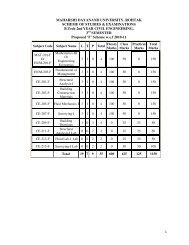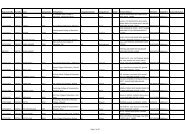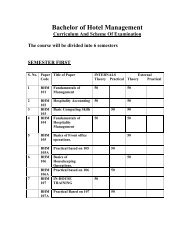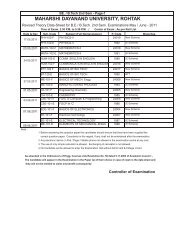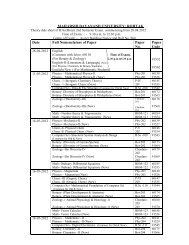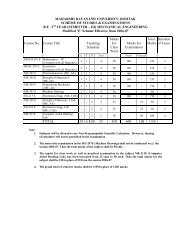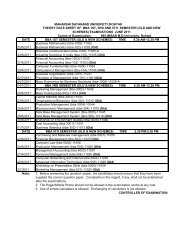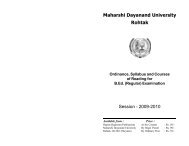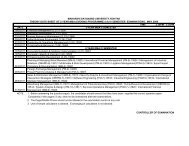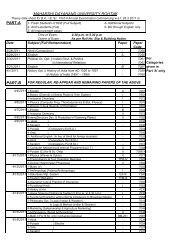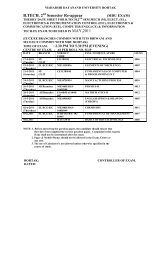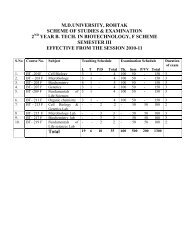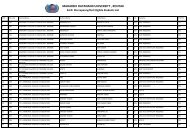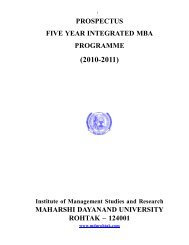B.Tech(CS) 3rd to 8th Sem - MDU, Rohtak
B.Tech(CS) 3rd to 8th Sem - MDU, Rohtak
B.Tech(CS) 3rd to 8th Sem - MDU, Rohtak
Create successful ePaper yourself
Turn your PDF publications into a flip-book with our unique Google optimized e-Paper software.
IT-303 E<br />
SYSTEMS PROGRAMMING &SYSTEM ADMINISTRATION<br />
L T P Class Work: 50<br />
3 1 - Exam: 100<br />
Total: 150<br />
Duration of Exam: 3 Hrs.<br />
Unit-1: Evolution of Components Systems Programming, Assemblers, Loaders, Linkers, Macros,<br />
Compilers. software <strong>to</strong>ols, Text edi<strong>to</strong>rs, Interpreters and program genera<strong>to</strong>rs, Debug Moni<strong>to</strong>rs,<br />
Programming environment.<br />
Unit-2: Compiler: Brief overview of compilation process, Incremental compiler, Assembler:<br />
Problem statement, single phase and two phase assembler, symbol table; Loader schemes, compile<br />
and go Loader, general loader schemes, absolute loader, Subroutine linkage, Reallocating loader,<br />
Direct linkage Loader, Binders, Linking loader, overlays.<br />
Unit-3: Macro language and macro-processor, macro instructions, features of macro facility,<br />
macro instruction arguments, conditional macro expansion, macro calls with macro instruction<br />
defining macros.<br />
Unit-4: Theoretical Concept of Unix Operating System: Basic features of operating system;<br />
File structure: CPU scheduling; Memory management: swapping, demand paging; file system: block<br />
and fragments, inodes, direc<strong>to</strong>ry structure; User <strong>to</strong> user communication.<br />
Unit-5: Getting Started with Unix: User names and groups, logging in; Format of Unix<br />
commands; Changing your password; Characters with special meaning; Unix documentation; Files<br />
and direc<strong>to</strong>ries; Current direc<strong>to</strong>ry, looking at the direc<strong>to</strong>ry contents, absolute and relative pathnames,<br />
some Unix direc<strong>to</strong>ries and files; Looking at the file contents; File permissions; basic operation on<br />
files; changing permission modes; Standard files, standard output; Standard input, standard error;<br />
filters and pipelines; Processes; finding out about processes; S<strong>to</strong>pping background process; Unix<br />
edi<strong>to</strong>r vi.<br />
Unit-6: Test Manipulation: Inspecting files; File statistics; Searching for patterns; Comparing<br />
files; Operating on files; Printing files; Rearranging files; Sorting files; Splitting files; Translating<br />
characters; AWK utility.<br />
Unit-7: Shell Programming: Programming in the Borne and C-Shell; Wild cards; Simple shell<br />
programs; Shell variables; Shell programming constructs; interactive shell scripts; Advanced<br />
features.<br />
Unit-8: System Administration: Definition of system administration; Booting the system;<br />
Maintaining user accounts; File systems and special files; Backups and res<strong>to</strong>ration; Role and functions<br />
of a system manager.<br />
Overview of the linux. operating system<br />
Text Books:<br />
Systems Programming by Donovan, TMH.<br />
The unix programming environment by Brain Kernighen & Rob Pike, 1984, PHI & Rob Pike.<br />
Design of the Unix operating system by Maurich Bach, 1986, PHI.<br />
Introduction <strong>to</strong> UNIX and LINUX by John Muster, 2003, TMH.<br />
Reference Book:<br />
Advanced Unix programmer’s Guide by Stephen Pra<strong>to</strong>, BPB<br />
Unix- Concept and applications by Sumitabha Das, 2002, T.M..H<br />
Note:<br />
Eight questions will be set in all by the examiners taking at least one question from<br />
each unit. Students will be required <strong>to</strong> attempt five questions in all.



